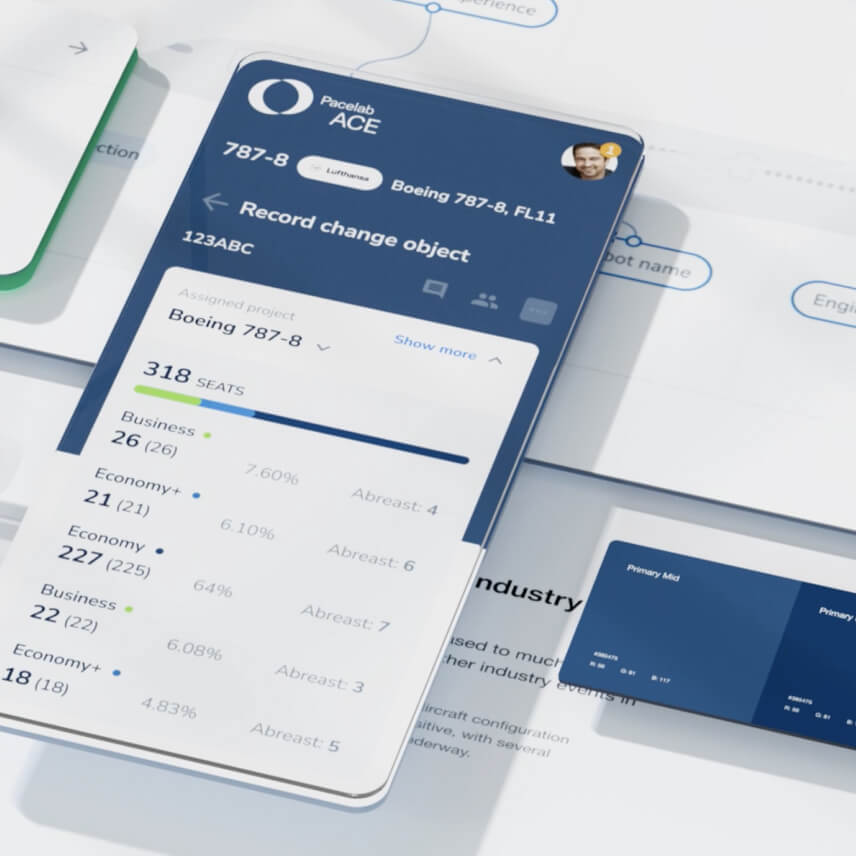Patients increasingly rely on digital solutions to fulfil their healthcare needs, including getting health advice, scheduling video call appointments, and tracking their health. At the same time, healthcare providers are leveraging software to streamline their operations, such as handling patient records and medications. As a result, the healthcare industry is witnessing rapid growth in adopting mobile apps, patient portals and other custom healthcare software, making designing user-friendly digital solutions more critical than ever.
Although the healthcare industry is undergoing digital transformation, most medical institutions tend to prioritise cost-saving measures, for example, sticking to existing patient portals instead of embracing the potential of updated versions to enhance user experiences. And while it is no secret that design plays a crucial role in organisational success, unfortunately, the healthcare sector has been sluggish in incorporating design innovations. The main reason change is so slow is because of strict regulations and a lack of willingness to shift.
In this article, Ihor Kornatovskyi, ELEKS Product Designer with over ten years of experience- including over four dedicated solely to healthcare software projects – will delve into the importance of design in the healthcare industry and highlight key challenges faced when designing solutions for such complex environment.
The basics of designing products for healthcare
Numerous studies have highlighted the potential consequences of medical errors, including financial waste for healthcare providers and, in some cases, patient fatalities. Poorly designed user interfaces (UI) in healthcare software can contribute to these errors.
Healthcare UX designers have the potential to make a significant impact by creating better technology and services. To achieve success in designing digital products for use in medicine, it's crucial to:
- have a deep understanding of complex healthcare ecosystem;
- have empathy towards both physicians and patients;
- involve healthcare providers in the design process;
- balance between patients’ and medical practitioners’ requirements while incorporating the latest trends and technology practices.
An example of this would be creating hospitals with ramps for accessibility purposes—just as software products should also be designed with accessibility at the top of mind. It is essential to develop health products and services that cater to a wide range of users, regardless of their abilities or disabilities. It includes considering the needs of individuals with visual, auditory, speech, motor, or cognitive impairments. Building an accessible and inclusive experience involves aspects such as colour contrast, text size, and creating a simple and easy-to-use navigation system.
But keep in mind technology alone does not always simplify clinicians' workloads nor solve problems automatically – this misconception only leads down a path where UX design could potentially make things more complicated.
Key benefits of user-centric healthcare product design
Well-designed healthcare products can save costs by making the best use of resources, improving efficiency and cutting down on mistakes or having to redo work. It benefits both healthcare organisations and patients.
With a user-centred approach, product design in healthcare puts the needs, preferences, and experiences of end-users at the forefront. By involving healthcare professionals, patients, and other stakeholders in the design process, solutions are tailored to their specific requirements, leading to higher adoption rates and better outcomes.
Designing products with accessibility in mind can profoundly impact making healthcare services and technologies more inclusive for individuals with disabilities or diverse needs. This approach ensures everyone has an equal opportunity to access the care they need.
Tackling key challenges in healthcare software product design
Designing healthcare software products comes with its own set of hurdles. Let’s look at three most common challenges designers encounter while crafting software for healthcare and how to overcome them:
Lack of user research
Without understanding users' unique needs and pain points, it is challenging to design software that meets their requirements. Conducting comprehensive user research can provide valuable insights and guide the design process. Here are the key features of effective research:
Carefully consider privacy, ethics, and legal requirements, while maintaining a customer-focused design process.
Acquire knowledge of various languages, contexts, services, and ecosystems to gain a deep understanding of clinicians' motivations and behaviours, ultimately enhancing the patient experience.
Observe, question, and form measurable hypotheses, which are then tested, analysed, and interpreted to drive iterative improvements in the solution. This approach often garners support from stakeholders due to its proven effectiveness.
If you have to make a choice between adding more features or refining the user experience, always choose the latter. The key to success is to give your users a better experience than your competitors. Usability testing is a key tool for achieving that goal.
Here are a few tips on how to achieve a balance and perfectly cover the needs of all parties:
- If we serve the business needs, we’ll create extremely efficient products with all of the financial incentives and rules in place to regulate the users.
- If we service the clinicians, we’ll build tools that make their lives easier but may not serve the business or the patients well.
- If we place patients as our top priority, we’ll likely establish a noble goal that, with careful pursuit, could serve business and clinician interests. However, even this latter goal could result in an extreme imbalance.
Inconsistent design of enterprise products
In healthcare, change isn’t embraced as much as in other industries. Healthcare products often have a strong technical and scientific focus, but they often fail to adequately consider the needs of the individuals involved, including doctors, nurses, and patients.
Moreover, many healthcare organisations have multiple software products from different vendors, resulting in a lack of consistency in terms of user interface and user experience.
- The consequences of inconsistent design systems within enterprise inner products:
-
- User confusion – inconsistency in the design system can lead to confusion as users encounter different interfaces and interaction patterns across the inner products. This confusion can negatively impact usability and user experience.
- Inefficient workflows– inconsistent design systems hinder seamless navigation and workflows between inner products. Users may struggle to perform tasks efficiently, resulting in slower and less productive work processes.
- Additional trainings and support – different products require extra trainings and support for before users learn how to use them. This added complexity could result in increased costs for the enterprise when it comes to training resources and ongoing support.
- Development and maintenance challenges – maintaining multiple inner products with inconsistent design systems can pose development challenges and lead to higher support and maintenance costs. Support teams must address unique issues for each product, adding complexity and resource requirements.
- Negative brand perception – inconsistent design across inner products can create a negative perception of the enterprise's brand. Any deviation from the standard may be viewed by users as an indication of incompetence or disregard for precision, ultimately damaging the image and credibility of your organisation.
Lack of data visualization
The design of healthcare systems goes beyond just providing convenience and ease of use for patients and clinical staff. It involves collecting, storing, and managing a vast amount of information, which was previously done manually but has now been automated. However, effectively operating and managing such data remains a significant challenge, even with technology.
Designers can tackle this challenge by employing data visualisation techniques that simplify complex information without compromising accuracy.
- Enhancing healthcare product UX via data visualization – insights from the healthcare providers' viewpoint:
-
- Quick and efficient data analysis – data visualisation helps providers analyse complex patient data for faster decision-making and improved care. It also allows reviewers to access care history, identify patterns, and suggest interventions.
- Enhanced data exploration – visualised data enables healthcare providers to interactively explore data, using charts and visualizations to filter, drill down, compare variables, and examine relationships. This interactive exploration helps providers gain deeper insights and discover valuable correlations that impact patient care strategies.
- Improved decision support & efficient management – data visualisation empowers healthcare providers with decision support, helping them identify key indicators, assess patient conditions, monitor treatments, and track progress. It also streamlines workflows, enhances care coordination, and optimizes resource allocation.
Conclusions
Our work in digital health design has been truly eye-opening. Having the opportunity to develop healthcare products that can make a real difference in patients' lives is an incredible honour, but it also comes with its share of challenges, such as lack of research and data visualisation.
To overcome these challenges, healthcare product designers must have a deep understanding of the complex healthcare ecosystem, empathy towards both physicians and patients, involve healthcare providers in the design process, and balance between the requirements of all stakeholders while incorporating the latest trends and technology practices.
Healthcare software development refers to the process of designing, creating, and implementing software solutions specifically tailored for the healthcare industry. It involves developing mobile and web applications, systems, and platforms.
Healthcare software product design refers to creating user-centred digital solutions tailored to the healthcare industry. It involves designing software applications, interfaces, and systems that improve patient care, enhance operational workflows, and support healthcare professionals in their daily tasks.
Healthcare software product design improves patient outcomes, streamlines healthcare processes, and enhances user experiences. Well-designed healthcare software can optimise clinical workflows, reduce medical errors, increase efficiency, and ultimately improve patient care quality.
The product design process involves several activities to create and develop new products or improve existing ones. While the specific activities may vary depending on the industry and company, here are some common steps and activities typically involved in the product design process:
- Research and analysis
- Concept development
- Prototyping
- Testing and evaluation
- Launching
- Post-launch evaluation and improvement
Related Insights

















